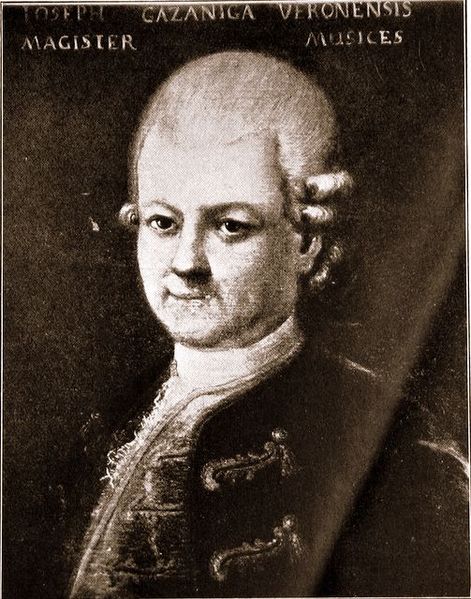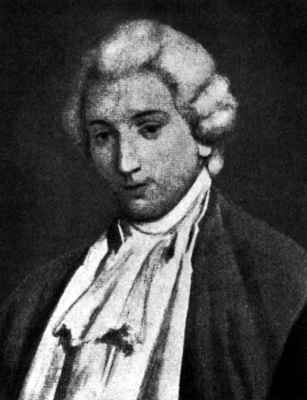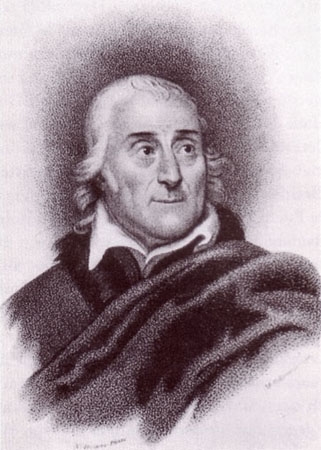<Back to Index>
- Librettist Giambattista Varesco, 1735
- Composer Giuseppe Gazzaniga, 1743
- Librettist Lorenzo Da Ponte, 1749
PAGE SPONSOR
Varesco's only familiar work with Mozart is the libretto to Idomeneo; the abortive L'oca del Cairo is little known. Varesco also edited Metastasio's libretto for Il re pastore, one of Mozart's lesser operas.
Mozart's commission for Idomeneo came in 1780 from Karl Theodor, Elector of Bavaria; his court in Munich paid Varesco 90 gulden. Leopold Mozart acted as a local intermediary for his son; their correspondence left many details on the collaboration, and showed the composer's dissatisfaction, primarily with the excessive length of the text. In a letter in December 1780 Mozart wrote:
Ask the Abbate Varesco if we could not break off at the chorus in the second act, Placido e il mare after Elettra's first verse, when the chorus is repeated, -- at all events after the second, for it is really far too long. (V.1. - 43/46)
Varesco resented the many cuts and changes that Mozart demanded, and insisted that his original text be published in full, which Mozart used as an excuse for cuts he made without the librettist's approval.
In a letter from Mozart to his father, who acted as a go-between for him in Salzburg, Mozart notes Varesco's admission that he had "not the slightest knowledge or experience of the theater."
By contrast with the extensive documentation of this uneasy
collaboration, we have no written record of the collaboration between Mozart and his greatest librettist, Lorenzo da Ponte, whose office was a short walk from Mozart's lodgings in Vienna.


Giuseppe Gazzaniga (October 5, 1743 – February 1, 1818) was a member of the Neapolitan school of opera composers. He composed fifty - one operas and is considered to be one of the last Italian opera buffa composers.
Born in Verona, Gazzaniga was initially intended for the priesthood at the urging of his devout parents. He eventually convinced his father to allow him to pursue a career in music and began studies first in Venice and then at the Conservatorio di Sant' Onofrio a Porta Capuana in Naples. While there, he was a pupil of Niccoḷ Piccinni and Nicola Porpora. Gazzaniga presented his first opera, il Barone di Trocchia, at the Teatro di San Carlo in 1768. He would spend the next several decades writing mostly operas in Italy with the exception of a few trips to Dresden, Vienna and Prague. His most successful opera was his Don Giovanni Tenorio written in 1787 to a libretto by Giovanni Bertati, possibly an inspiration for the libretto of Mozart's Don Giovanni. His last opera, Martino Carbonaro o sia Gli sposi fuggitivi, was performed at the Teatro San Moisè in Venice in 1801. He also wrote a symphony and three piano concertos.
In 1791, he became musical director of Crema Cathedral in the Lombardy region of northern Italy, where he composed numerous sacred works including several cantatas, oratorios
and masses. He remained in that position until his death in 1818. His
life and works were the subject of a detailed study by the prominent
19th century German critic Karl Chrysander.

Lorenzo Da Ponte (10 March 1749 - 17 August 1838) was a Venetian opera librettist and poet. He wrote the librettos for 28 operas by 11 composers, including three of Mozart's greatest operas, Don Giovanni, The Marriage of Figaro and Coś fan tutte.
Lorenzo Da Ponte was born Emanuele Conegliano in Ceneda, in the Republic of Venice (now Vittorio Veneto, Italy). He was Jewish
by birth. His parents were Geremia Conegliano and Rachele Pincherle. He
had two brothers; Baruch (later christened Girolamo, 1752 - 1783) and
Anania (later christened Luigi, 1754 - 1781). Rachele died giving birth to
Anania in 1754. In 1763 the widower Geremia Conegliano converted
himself and his three sons to Roman Catholicism
in order to marry the seventeen year old Orsola Pasqua Paietta. She was
only three years older than the fourteen year old Emanuele, who took
the name of Lorenzo da Ponte from the Bishop of Ceneda who baptized
him and, according to custom, gave the family his name. Thanks to the
bishop, the three brothers studied at the Ceneda seminary. The bishop
died in 1768, after which Lorenzo moved to the seminary at Portogruaro,
where he took the Minor Orders in 1770 and became a priest in 1773.
He soon moved to Venice, where he made a living as a teacher of Latin, Italian and French. Although he was a Catholic priest, the young man led a libertine and dissolute sexual life, which earned him the enmity of the clergy, as well as of several rivals and cuckolded husbands. While priest of the church of San Luca in Venice, he took a mistress, Anzoletta Bellaudi, who was married. Da Ponte delivered their first child, an event which he commented was "the kind of incident that happens every day." Reprimanded by the vicar general, Da Ponte and Anzoletta opened a brothel. In 1779 he was charged with "public concubinage and rapito di donna onesta" (abduction of a respectable woman). Da Ponte was tried by the Inquisition and banished for fifteen years from the Serenissima Repubblica di Venezia (Most Serene Republic of Venice).
Lorenzo da Ponte moved to Gorizia, then part of Austria, where he lived as a writer, attaching himself to the leading noblemen and cultural patrons of the city. In 1781 Caterino Mazzolà, the poet of the Saxon court, called him to Dresden, and taught him how to write libretti for operas. With the help of Antonio Salieri, Lorenzo da Ponte traveled to Vienna, Austria, and applied for the post of Poet to the Theaters. Emperor Joseph II reportedly asked him how many plays he had written. Da Ponte replied "None, Sire," to which the Emperor reportedly replied "Good, good! Then we shall have a virgin muse."
As court librettist in Vienna, he wrote texts in French, German, Spanish and Italian, and collaborated with Wolfgang Amadeus Mozart, Antonio Salieri and Vicente Martín y Soler.
Lorenzo da Ponte wrote the libretti for Mozart's greatest Italian operas, Le Nozze di Figaro (1786), Don Giovanni (1787), and Coś fan tutte (1790). These operas were first staged in Prague, and became instant successes. Da Ponte became known as the greatest Italian librettist of his time.
With the death of Austrian Emperor Joseph II in 1790, Da Ponte lost
his patron. He received little interest from the new Emperor, Leopold.
In fact, thanks to his enemies' intrigues, Da Ponte fell into disgrace
with Leopold and had to leave Vienna on that account. He could not
return to Venice, from which he had been banished until the end of 1794.
In 1791, Wolfgang Amadeus Mozart died at the age of 35, and Lorenzo da
Ponte lost his closest friend. Lorenzo da Ponte moved to Prague, where
he had enjoyed his greatest success as the librettist of Mozart's
Italian operas, and then in 1792 to London,
where he began a new career there as an opera producer and remained
there until 1805. In London, Lorenzo da Ponte was introduced to Ann
Celestine Grahl (known more commonly as Nancy), a wise and practical
woman twenty years younger than him, who became his wife for the latter
part of his life and was the mother to da Ponte's four children: Louisa
(1794), Fanny (1799), Joseph (1800) and Lorenzo (1804). Da Ponte,
however, had little interest in business, and as he had done in Venice
and in Vienna, got himself in trouble. He eventually found himself in
debt and bankrupt. To escape his creditors, he fled to the United States
in 1805 with his wife and children. Nancy's family had already settled
there.
In the United States, Da Ponte settled in New York first, then Sunbury, Pennsylvania, where he briefly ran a grocery store and gave private Italian lessons. He returned to New York to open a bookstore. He became friends with Clement Clarke Moore, and, through him, gained an appointment as the first professor of Italian literature at Columbia College. He was the first Roman Catholic priest to be appointed to the faculty, and he was also the first to have been born a Jew. In New York he introduced opera and produced a performance of Don Giovanni. He also introduced Gioachino Rossini's music in the U.S., through a concert tour with his niece Giulia da Ponte.
In 1828, at the age of 79, Lorenzo da Ponte became a naturalized U.S. citizen. In 1833, at the age of eighty - four, he founded the first opera house in the United States, the New York Opera Company. Owing to his lack of business acumen, however, it lasted only two seasons before the company had to be disbanded and the theater sold to pay the company's debts. It was, however, the predecessor of the New York Academy of Music and of the New York Metropolitan Opera.
Lorenzo da Ponte died in 1838 in New York; an enormous funeral ceremony was held in New York's old St. Patrick's Cathedral on Mulberry Street. Some sources state that Da Ponte is buried in Calvary Cemetery in Queens, but that cemetery did not exist before 1848. Other sources say da Ponte was buried in lower Manhattan. Calvary Cemetery does contain a stone marker to serve as a memorial to Da Ponte.
All of Da Ponte's works were adaptations of preexisting plots, as was common among librettists of the time, with the exceptions of L'arbore di Diana with Vicente Martín y Soler, and Coś fan tutte, which he began with Salieri, but completed with Mozart. However the quality of his elaboration gave them new life, in particular the Don Giovanni character, often seen in contrast with Giacomo Casanova as the archetypical libertine character.